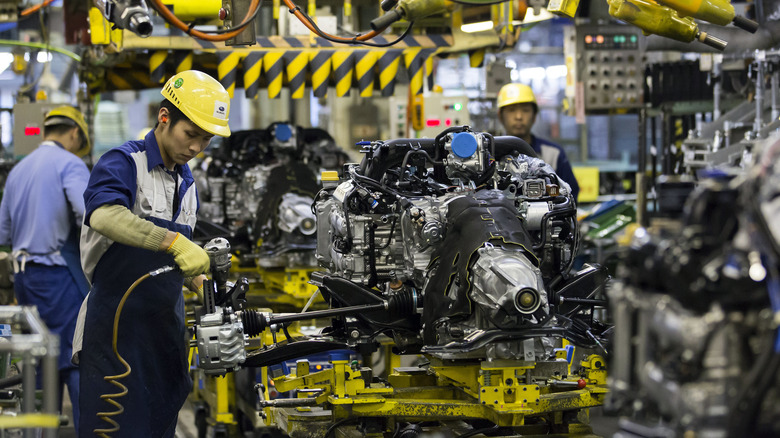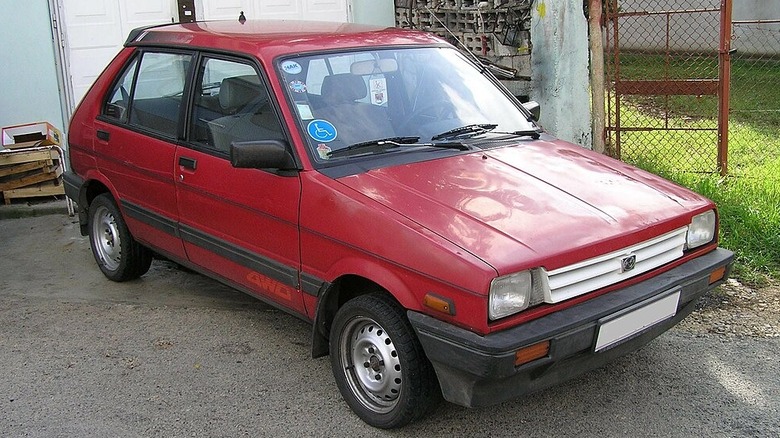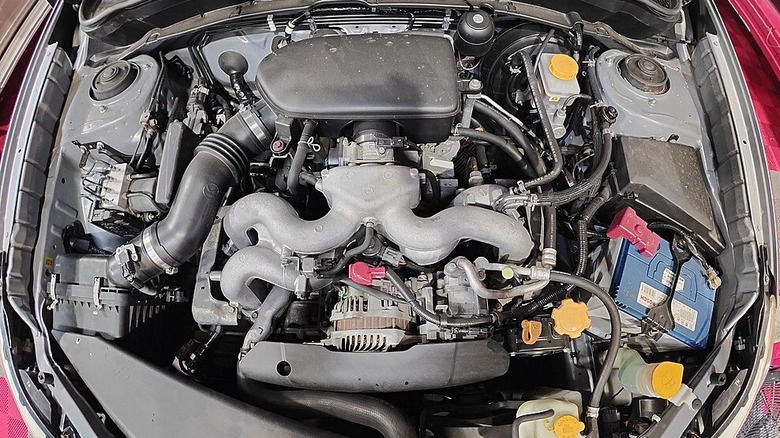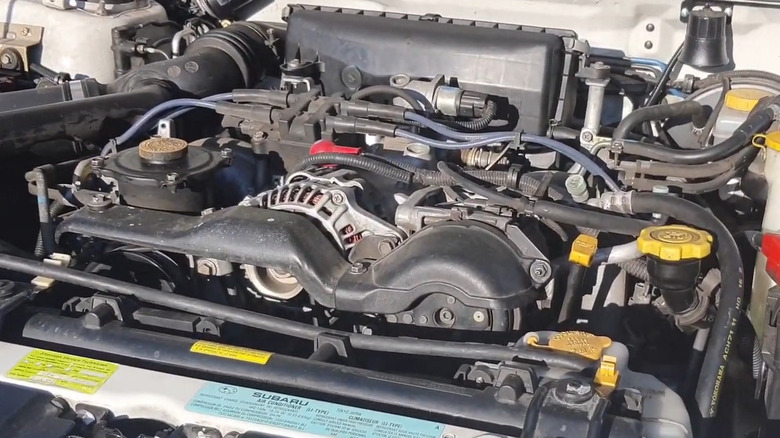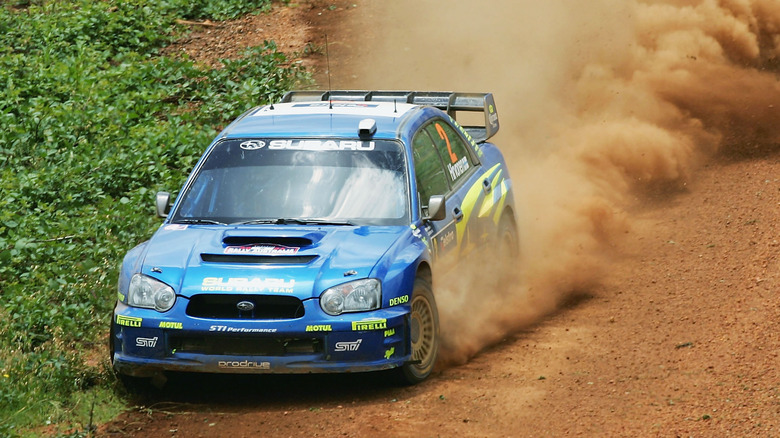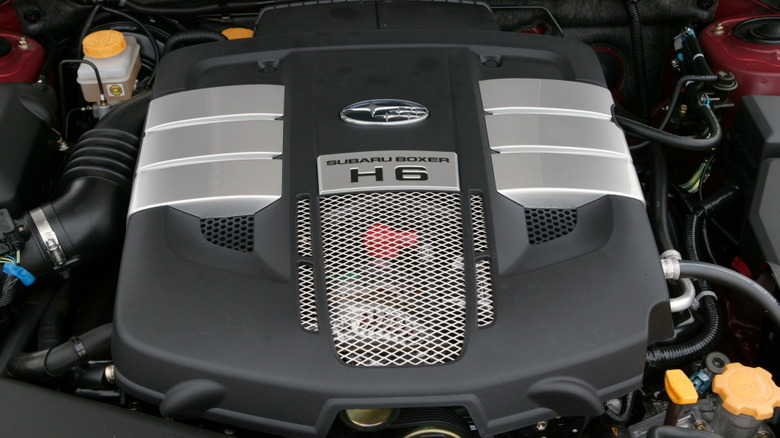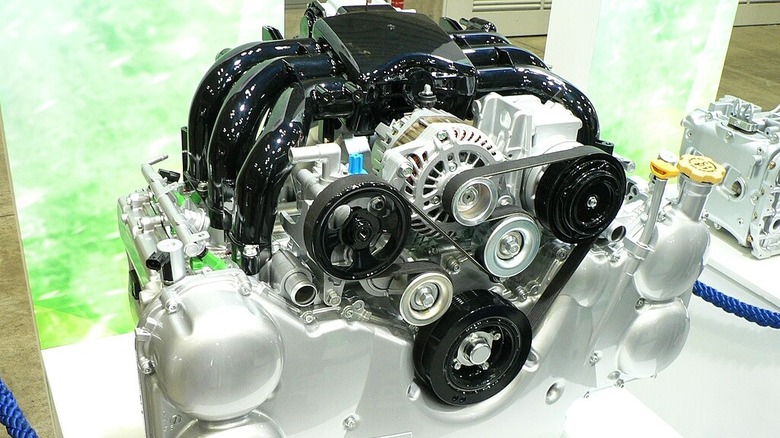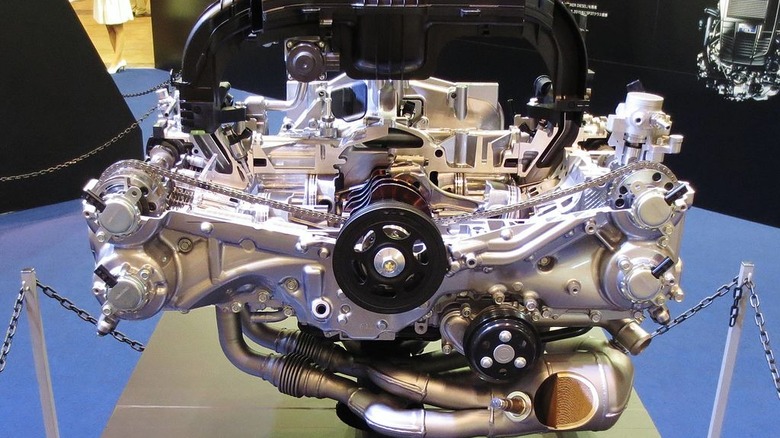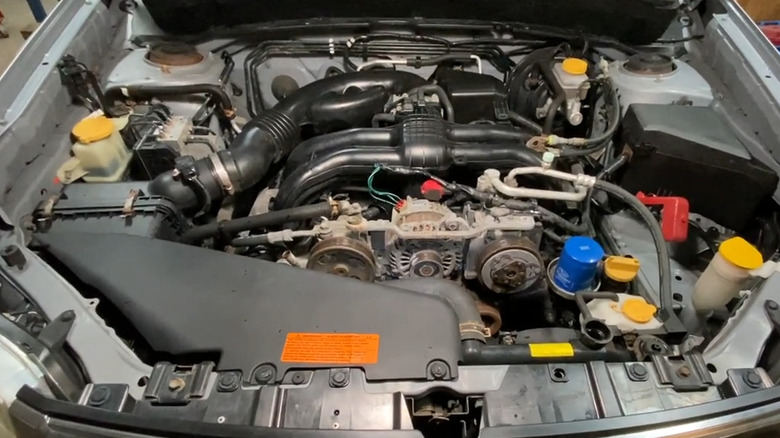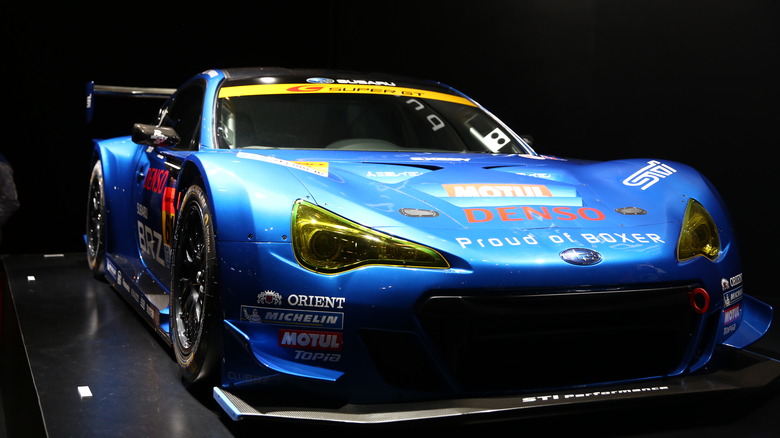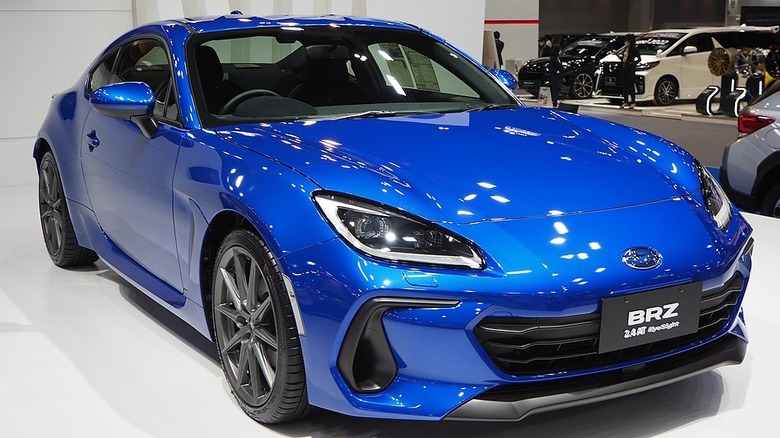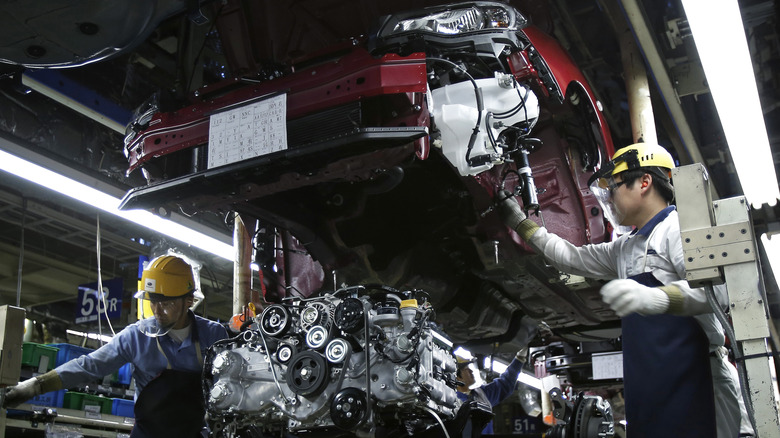10 Of The Most Reliable Subaru Engines Ever Made
Japanese automaker Subaru is known for its reliability. Its vehicles have a reputation for being some of the longest-lasting in the industry, and the engines that power those vehicles need to be reliable for the Outbacks, Imprezas, and Crosstreks the company produces to stay on the road. The vast majority of Subaru vehicles are equipped with some form of the boxer engine. Porsche is the only other auto manufacturer that regularly uses the boxer, a horizontally mounted engine that features cylinders that lie flat. When the engine's pistons move past one another, it resembles the arms of sparring boxers, giving the engine its quirky name.
Subaru says the boxer engine has many benefits, including a lower center of gravity than inline or v-style engine configurations, a smaller and lighter design, and a symmetrical setup that works well with the company's all-wheel-drive systems. However, the engine's position under the hood makes for a tight fit — just ask any technicians who have had to change the side-mounted spark plugs on an Outback.
Reliability, while a subjective term, is what these engines have staked their existence on. This list of the most reliable Subaru engines aggregates model reports to determine which engines were in the brand's longest-lasting cars, and incorporates data from social media, local technicians, and respected review sites. A further explanation of the methodology can be found at the end of this article.
EF12
The engine equipped in all Subaru Justys sold in the United States was the EF12. Introduced in 1984, it was based on Suzuki's G10 engine, which was found in cars like the Suzuki Cultus, Pontiac Firefly, and Geo Metro. But while the G10 featured an aluminum block and cylinder head, Subaru's Justy engine had a closed deck iron engine block. That design choice is part of the reason why these engines are still attainable to this day.
The straight-three, four-stroke engine featured a single overhead camshaft and, while small, was relatively powerful for its size. When multiport fuel injection was added to the EF12 in 1990, the engine was able to produce 73 horsepower — an impressive one horse per cubic inch of displacement. 73 horsepower isn't huge, but the addition of a turbo was able to double the power, and enthusiasts even report these engines producing 200 horsepower with reasonable lifespans after some modification.
The EF12-E, the version that included fuel injection, was the last of the EF12s. When Subaru decided to discontinue the Justy in 1994, the EF12 went with it. However, despite the difficulty involved in finding or reproducing parts for the EF12 and the Justy, obsessives continue to share tips and tricks for substitutes to keep their beloved Subaru Justys running. Even remanufactured EF12 engines are out there for those willing to find them, rebuilt and machined to OEM specifications.
EJ20
The 2.0-liter turbocharged boxer that powered the iconic blue-and-yellow Subaru WRX to several rally championships was a part of the EJ20 series of engines. Introduced in 1989, versions of the EJ20 were found in the Legacy, Impreza, and Outback. It's a four-cylinder boxer with an aluminum block and heads, and the engine's open deck design saved on weight, although at the sacrifice of structural support around the top of the cylinders. That's not an issue for low-powered vehicles, but as pressures and power increase, more support in the way of a semi-open or closed deck is preferred.
The EJ20 also produces the sound that many gearheads most closely associate with Subarus. That "Subie rumble" is produced by slight differences in the lengths of cylinders one and three versus those of two and four — the sound travels differently from the one pair of cylinders to the exhaust, creating a unique note.
EJ20s are generally considered to be reliable. The WRX's EJ205 is a 2.0-liter powerhouse with up to 227 horsepower and a long life expectancy if properly maintained. But if they eventually do fail, tuners and racers will often replace them with the Japanese Domestic Market (JDM) versions — either that country's EJ205s or a higher-revving Japanese exclusive EJ207. While the transition isn't as straightforward as yanking the old engine and plopping in a substitute — the Japanese engines had AVCS variable cam timing controls that the North American ones lacked — it's a doable procedure for a capable technician who knows Subarus.
EJ22
Considered "bulletproof," the EJ22 is often called Subaru's most reliable engine. It's a 2.2-liter four-cylinder boxer engine, and the estimated life of the EJs is over 250,000 miles, with many drivers reporting over 500k. The EJ22's many variations were used in some form from the 1990 Legacy's EJ22E, all the way up to the 2001 Impreza's EJ222.
SlashGear asked the opinions of a pair of former Subaru dealership technicians. "We both agree the EJ22 [is the most reliable] as it's closed deck and non-interference," they told us. This statement provides important insight into the dependability of the EJ22. Closed deck design is much more stout when compared to open deck — the top of the cylinders are supported by much more material in a closed deck setup, allowing for higher cylinder pressures and, as a result, more power without risking damage to the engine or heads.
"Non-interference" refers to the design of the engine. In a non-interference setup, the valves and pistons inside the combustion chamber don't take up the same space. That way, if the timing belt were to break, the risk of the pistons and valves colliding — resulting in bent or even broken valves — is practically impossible. However, interference engines can provide higher compression and power, making them the norm. Subaru began producing interference engines in 1996, meaning Subie owners need to be diligent in keeping the timing belt replaced on schedule. It's a normal maintenance item, but one that can't be ignored.
EJ257
This is a very touchy subject for a lot of Subaru diehards. On the one hand, it's an engine in the EJ25 lineup. Even technicians who don't specialize in Subarus know the reputation of the naturally aspirated EJ25s — they blow head gaskets, and it happened often enough to trigger multiple class-action lawsuits. However, the EJ257 is such a beloved rally powerhouse that it felt like a necessary addition to any list of Subaru engines, and there are ways to mitigate, if not solve, the issues the EJ25s present.
The EJ257 was designed specifically for the United States Domestic Market (USDM) 2004 Impreza WRX STI. It's a 2.5-liter turbocharged EJ, featuring 300 horsepower and 300 lb-ft of torque. It features a semi-closed block, meaning the tops of the cylinders are stabilized by several attaching points to the engine. There was an ultra-special version of the EJ257, tuned by Cosworth and made available to only 75 UK-only buyers. That engine was found in the Cosworth WRX STi CS400, a monster that produced 395 horsepower and 398 lb-ft of torque. Those are great specs if you can find the vehicle, but be prepared to spend a lot — recent auctions sold the 2010 vehicle for over $55,000.
While bearing and ringland issues were prevalent in early versions of the EJ257, and they never entirely went away, proper tuning and maintenance help keep the engine reliable and running in WRX STis to this day.
EZ30
While Subaru is known for its four-cylinder boxer engines, the company has also had success with six-cylinder power plants. The EZ30, sometimes called the H6, is one of the most popular, although it wasn't the first. That honor goes to the ER27 engine in the late '80s Subaru XT6. The XT6 is notable for its engine and for being one of the most aerodynamic cars of the time.
Designed from scratch in 1999 and then found in the Legacy and Outback, later versions like the EZ30D and EZ30R were also used in Outbacks, Legacies, and the new Tribeca. While it was discontinued in 2009, it's considered a reliable engine, with a timing chain that should last the lifetime of the engine rather than a 60k-rated belt.
The Subaru technicians told us, "The EZ30 is a close second [after the EJ22] but the only issue is the timing cover leaks." Issues with oil leaks from the timing cover and valve cover gasket are often mentioned, and it does feature the open-deck design we complained about earlier. For drivers running the vehicle stock, that's not a problem. Subaru's 3.0-liter boxer was made for its large SUVs, with revisions going into the Tribeca. 150-180k is often cited as the lifespan of these six-cylinder engines, and later versions like the EZ30R are popular platforms for modification, owing to their big displacement, light weight, and good compression ratios.
EZ36
Replacing the EZ30 in the immediately redesigned Tribeca in 2008 (the first year of the Tribeca featured a little nose bump along the hood that was largely disliked) the EZ36 was the largest displacement engine Subaru had ever produced. In that vehicle, it produced 256 horsepower and 247 lb-ft of torque. Variable valve timing was added for both of the flat-six engine's dual overhead cams, along with changes to compression ratios, intake and exhaust manifolds, and the cooling system.
After replacing the EZ30 in the Tribeca, the EZ36 became the standard 6-cylinder engine in the Legacy and Outback as well. By the 2010 model year, the 3.6-liter engine had replaced its 3.0-liter predecessor altogether. The EZ36 is largely considered a more dependable version of the engine it replaced, with a life expectancy leaning closer to the EZ30's top end of 180k. Similar gasket leak issues to the EZ30 exist with the EZ36, and the larger engine size does tend to make repairs outside a shop environment difficult. But overall, this big six-banger delivers on performance and reliability.
FB20
The replacement for the long-running 2.0-liter EJ series of engines, the FB series, has garnered respect as a reliable substitute. The FB20, another flat-four 2.0-liter like its predecessor, was announced in 2010 and features improvements to emissions, fuel consumption, and a broader band of torque. Subaru also touted a 30% reduction in friction loss due to the use of lightweight pistons and connecting rods. FB20s were also the first Subaru engines to employ direct fuel injection, which improves fuel efficiency but also tends to leave carbon deposits on valves.
An issue with excessive oil consumption led to a class action lawsuit that was settled out-of-court, with the problem engines serviced under warranty. While keeping an eye on the oil levels of any FB engines — and, really, most engines in general — can mitigate many long-term issues, it's worth checking to see if an older-model Subaru one might be purchasing has had that warranty work performed.
The FB20 is the basis for a few engines that incorporate hybrid electric motors. The FB20X, FB20V, and FB20D e-Boxer have all been used in various Subaru XVs, Crosstreks, and Imprezas.
FB25
Announced at the same time as its 2.0-liter baby brother, the FB25 was another redesign intended to take Subaru into the 2010s and beyond. Built off of the same aluminum cylinder block as the FB20, the FB25 also received many of the same improvements, like dual AVCS, new pistons, and two-piece aluminum heads that reduced the weight of the engine. Timing chains remained the choice over less dependable belts.
While the oil consumption issues present in the FB20 were also present with the FB25, it's important to note that those issues only affected around 5% of these engines. Although the direct fuel injection issues in FBs are common among any vehicle using that setup, it's not an issue that would affect the lifespan of the motor — a simple walnut blasting at a reputable shop cleans intake valve and port deposits and brings overall power back to spec.
As the FB20 replaced the EJ20, so the FB25 did for the EJ25s in Legacys and Foresters. It produces around 170 horsepower and 170 lb-ft of torque, and drivers say it's more responsive than the EJ25 at lower speeds. Fuel efficiency is also vastly improved over the EJ. Overall, the FB25 is considered an improvement over the AJ25 and has a lifespan of around 200,000 miles.
FA20
The BRZ was a unique addition to the Subaru lineup, and its FA20D engine contributed to that. The sporty coupe was powered by an engine that was jointly developed by Toyota and Subaru. The FA20D and its counterpart, the Toyota 4U-GSE, were used in the Subie BRZ, the Toyota 86, and the Scion FR-S.
The FA line of Subaru engines are the modern power plants for the more performance-oriented vehicles in the automaker's lineup. Where the FB engines, as we mentioned, replaced the venerable EJs, the FAs were installed in cars like the WRX, Legacy, Forester, and BRZ — not all rally racers, but all now powered by dependable engines with modern engineering. The FA20 was named one of Ward's AutoWorld's 10 Best Engines in 2013.
The 2.0-liter FA20 was built off of the block used by the FB20 but with new pistons, rods, and a new crankshaft. The FA20 has a higher compression ratio and uses Toyota's direct fuel injection system. It's got an open deck design and also has a version with a turbocharger for some extra oomph. But, most importantly for our purposes, it's considered a reliable motor when driven sensibly and kept properly maintained.
FA24
The FA24D, which appeared in both the 2022 Subaru BRZ and the '22 Toyota GR86, is the second collaboration between Toyota and Subaru. It addressed issues like torque dip and high oil temps. Meanwhile, the turbo version, the FA24F, debuted in the Ascent before being announced as the powerplant for the WRX, as well as being an optional upgrade for certain Legacies and Outbacks. While the FA and FB engines are still relatively new, their lifespans and reliability have already produced promising estimates.
When the FA24 was put into the WRX, it wasn't as simple as putting the same engine in a different vehicle. The version that went into the Ascent was designed for torque, with the 2019 SUV's marketing pushing its ability to tow 5,000 pounds using its 260 horsepower and 277 lb-ft of torque. When modifying the engine for the WRX, a twin-scroll turbo helped boost the engine's power to 271 horses, while torque dropped down to 258 lb-ft.
While it's difficult to judge an engine that's only been around a few years, tuners and reviewers agree that the FA24, in all its iterations, seems dependable. BRZ track drivers have discovered some issues with oil pan gasket sealant blocking the oil pickup and pressure drops on turns, but for everyday drivers, those shouldn't become concerns.
Methodology
While "reliability" as a concept can be thought of as subjective — for example, if an owner's Outback fails to start after 100 miles, they will likely say that the car is "unreliable" — there are several sources that have performed significant research in that specific metric. Things like longevity, maintenance required and its cost, and time the vehicle spends in the shop are all taken into account.
"Reliability" and "dependability" ratings were obtained by looking over model dependability ratings and reports, and then digging into the engines powering those vehicles. Opinions on reliable Subaru engines were gathered via social media. SlashGear also took into account the author's experience working in auto shops in Colorado, a state where the Subaru Forester is the best-selling vehicle. Finally, the author spoke directly to the people responsible for keeping those engines running, questioning a pair of former Subaru technicians — thanks to Shane and Aaron for their contributions.
